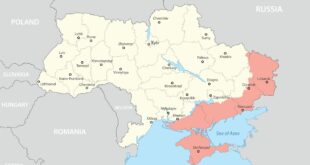As The Duran’s readers may recall, during April the headlines were filled with stories of North Korea planning a sixth nuclear test, of President Trump warning of the US being prepared to take unilateral action if North Korea’s nuclear programme was not stopped, of the the US carrier Carl Vinson with its accompanying “armada” closing on North Korea and of the US submarine USS Michigan with its vast battery of cruise missiles doing the same, of the entire US Senate being called to the White House to be briefed about the threat from North Korea, of the ‘Mother of All Bombs’ being dropped on ISIS in Afghanistan as a ‘warning’ to North Korea, and of Wang Yi – China’s Foreign Minister – warning that war might break out on the Korean Peninsula at any moment.
In the event April has passed with no sign of a North Korean nuclear test and no military action by the US. North Korea in the meantime has essentially dropped out of the news whilst South Korea has elected a new more liberal minded President – Moon Jae-in – who seems intent on reducing tensions in the Korean Peninsula, has spoken of his desire to travel to North Korea to meet with Kim Jong-un, and who within a day of his inauguration spoke over the telephone with Russia’s President Putin, with the Kremlin’s summary of their conversation containing these interesting words
While exchanging views on the situation on the Korean Peninsula, both leaders underlined the importance of finding ways to resolve the crisis politically and diplomatically.
(bold italics added)
Whilst unilateral military action against North Korea by the US against South Korean opposition might in theory be possible, in practice it would be politically extremely difficult. The fact that President Moon Jae-in appears to oppose it makes it extremely unlikely it will happen.
So why did the war that seemed so near to happening in April never happen?
I have already said why I strongly doubt the widely held view that all the talk of war in April was to provide political cover for the US to deploy THAAD to South Korea. Briefly, THAAD was going to be deployed anyway and there was no need for the US to escalate tensions to such extraordinary levels in order to achieve it and the risk involved in escalating tensions was far too great to justify doing it for such a purpose.
There is a possibility that war was averted because North Korea was deterred by the threats issuing from the US, and that this explains why it did not carry out a nuclear test. Alternatively it may be that US threats scared China to threaten North Korea with all embracing sanctions – including supposedly a 6 month embargo on oil supplies – and that it was this which caused North Korea to put off conducting a nuclear test, which in turn took away the reason for the US to carry out a military attack.
However the problem with these theories is that we do not actually know that North Korea was planning a nuclear test in April and was deterred by the US and/or China from carrying it out.
North Korea never announces its nuclear tests in advance and when they take place it usually comes as a surprise. Contrary to what is often claimed, there is no exact correlation between North Korean nuclear tests and North Korean public holidays, with only one nuclear test – the last test, which took place on 9th September 2016 – being held on the same day as a North Korean public holiday (the anniversary of the founding of the North Korean Republic). The fact that North Korea was due to celebrate two important public holidays in April – the anniversary of Kim Il-sung’s birth on 15th April and the anniversary of the founding of the North Korean army on 21st April – is not in itself a reason to think that a further nuclear test was planned for April to coincide with either of these days, despite widespread suggestions in the media that that was the case.
North Korea has carried out five nuclear tests in the eleven years since its first nuclear test on 9th October 2006, with two tests (one allegedly of a hydrogen bomb and one allegedly of a miniaturised nuclear device suitable for use in a missile warhead) carried out in 2016. A sixth test in April 2017 would have meant three tests over a period of fifteen months, signalled a very marked acceleration in the nuclear test programme. Whilst that is possible it is actually unlikely especially as computer simulations well within the abilities of North Korea’s computer technology make nuclear tests far less important today than they were during the height of the US and USSR’s nuclear test programmes in the 1950s.
North Korea has repeatedly said that it will not be deterred from carrying out nuclear tests because of threats of military action by the US. North Korea took the unusual step at the beginning of May of also publicly criticising China for threatening sanctions in the event of a further nuclear test. Reuters reports parts of the commentary of the Korean Central News Agency (North Korea’s official news agency) as saying the following
The KCNA commentary charged that the Chinese articles had attempted to shift the blame to Pyongyang for “deteriorated relations” between China and North Korea and U.S. deployment of strategic assets to the region.
It also accused China of “hyping up” damage caused by North Korean nuclear tests to China’s three northeastern provinces.
Chinese state media calls for North Korea to dismantle its nuclear program were “a wanton violation of the independent and legitimate rights, dignity and supreme interests” of North Korea and constituted “an undisguised threat to an honest-minded neighboring country which has a long history and tradition of friendship,” it said.
The KCNA commentary said calls by “some ignorant politicians and media persons” in China for stricter sanctions on North Korea and not ruling out military intervention if it refused to abandon its nuclear program, were “based on big-power chauvinism.”
It said North Korea’s nuclear program was needed for the “existence and development” of the country and “can never be changed nor shaken.”
“The DPRK will never beg for the maintenance of friendship with China,” the commentary said.
(bold italics added)
These words are an emphatic rejection by North Korea of Chinese calls for North Korea to slow down or halt its nuclear weapons programme. Perhaps the words are bluff, but they strongly suggest that Chinese pressure to slow down or stop North Korea’s nuclear test programme is being resisted – or more probably rejected – in which case Chinese pressure almost certainly was not the reason North Korea did not carry out a nuclear test in April.
Obviously without access to classified intelligence information about the state of North Korea’s nuclear test programme it is impossible to say with any certainty whether or not North Korea planned a nuclear test in April. However on balance it seems most likely that it did not.
On balance it is difficult to avoid the impression that the reason no war happened in the Korean Peninsula over the course of April is because none was ever intended and that the threats of war that were issuing from the US over the course of that month were simply bluff, intended to intimidate China rather than North Korea. If so then the reason why there has been no war and why the whole Korean crisis has abruptly dropped out of the news is because when China called the US’s bluff – during the telephone conversation between Chinese President Xi Jinping and US President Donald Trump on 23rd April 2017 – the US had no option but to switch the whole ‘crisis’ off.
In a sense this is reassuring. That Donald Trump was bluffing started to become increasingly obvious as the whole fake ‘crisis’ unfolded. The fact that he pulled back shows that he knows how to do this when his bluff is called and moreover that he does it without rancour.
However it is never wise to fabricate an international crisis involving a nuclear armed state like North Korea as a bluff, especially if doing so is inevitably going to lead to the bluff being called. Hopefully the President has learnt his lesson, and we will see a more conventional approach to diplomacy from the Trump administration in future.
 Geostrategic Media Political Commentary, Analysis, Security, Defense
Geostrategic Media Political Commentary, Analysis, Security, Defense





